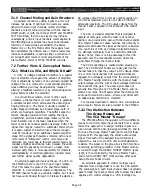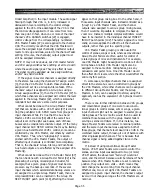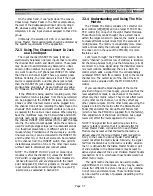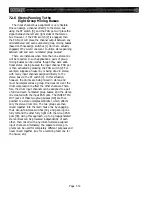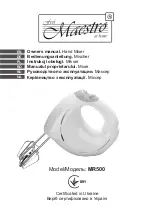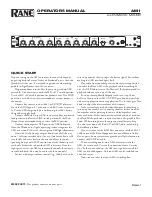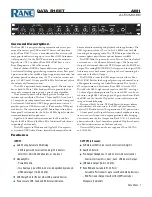
Section 7.
Operating Notes and Hints
This section is not meant to be comprehensive.
Instead, it focuses on a few areas which we feel require
special attention, or where a better understanding of
the function can lead to far more utility or better sound
quality from the PM4000.
7.1 Console Gain Structure
In the GAIN STRUCTURE AND LEVELS section of
this manual, we discuss some general considerations
regarding levels and system setup. What of the proper
gain structure within the PM4000? How can the many
faders and other level controls that affect a given signal
all be adjusted for the optimum results? These are
important questions to ponder, and we hope you will
take some time to study the possibilities.
7.1.1 What Is The Proper Gain Structure?
Let’s begin with the XLR channel input to the
console. According to the INPUT CHARACTERISTICS
chart in the SPECIFICATIONS section, the nominal
input level ranges from -70 dBu (0.25 mV) to +10 dBu
(2.4 V). These are the levels that will supply the ideal
signal level throughout the module with the PAD set to
0 dB or -30 dB, the input GAIN control as required,
fader set to its nominal position, and no VCA groups
assigned. Actually, a wider range of levels can be
accommodated if the fader is adjusted to other-than-
nominal position; from -90 dBu (0.025 mV) minimum to
+24 dBu (12.3V) maximum.
What is the correct gain structure? Simply stated, it
is the level at which there remains adequate headroom
so that peaks can be accommodated without clipping,
while at the same time there is sufficient “distance”
above the noise floor that noise does not become objec-
tionable. If a signal is too high in level (too “hot”) at a
given point in the console, then peaks or, in the ex-
treme, the entire signal, will be subject to distortion. If
the signal is too low in level, there may be considerably
more headroom and less risk of distortion, but the noise
will be that much more noticeable, and quiet passages
may be masked entirely by residual noise. The “ideal”
level, then, where headroom and noise tradeoffs are
optimum, is also known as the nominal level. There is
no single value for the correct nominal level; it varies
throughout the console. This is what the middle graph
line in the GAIN STRUCTURE chart in Figure 3-??
depicts. The top graph line indicates the clipping point.
The distance between these two lines, at any point
along the horizontal signal flow scale, depicts the
available headroom. It is important that wide headroom
be available throughout a console, not just at the input
and output; otherwise multiple signals applied to the
busses may add together such that the mixed level
approaches clipping, even though the individual feeds to
the mix are within their acceptable nominal range.
Sometimes a group or master fader can be adjusted to
correct this condition, other times it cannot because the
distortion is occurring in an amplifier ahead of the
fader, and the only cure is to lower the signal levels
applied to the bus. How can one know the best course of
action when distortion, or excess noise, is encountered?
7.1.2 What Affects Gain Structure?
First, understand that signal levels can be increased
by either increasing amplifier gain (including EQ boost),
reducing the amount of attenuation, or adding multiple
signals together. Similarly, signal levels can be reduced
by either decreasing amplifier gain (including EQ cut),
increasing the amount of attenuation (including filter
roll-off), or splitting the signal to feed two or more
circuits. With this in mind, it becomes clear that the
mere act of feeding the “correct” nominal level signal
into a console is no guarantee that it will remain at an
acceptable level throughout the console.
7.1.3 Establishing The Correct
Input Channel Settings
In the case of the PM4000, the input channel meter
LEDs [20] [20S] make it relatively simple to obtain the
correct gain structure at the input stage. Begin with the
PAD set at maximum attenuation (-30 dB), the GAIN
control centered, and apply the typical input signal to
the channel input. If none of the meter LEDs are
illuminated, or perhaps just the -20 LED, disengage the
attenuation PAD switch to remove the 30 dB of attenua-
tion. Adjust the GAIN control as required so that the
red PEAK LED flashes on only occasionally, during the
loudest program peaks, and the 0 LED flashes fre-
quently or remains on. This establishes the correct
channel sensitivity for the initial setup (you may wish
to alter these values during an actual program mix, as
explained in subsequent paragraphs).
NOTE: It is a good idea to set the Group Master Faders,
the Stereo Master, and all Aux Master controls at a very
low level during the initial stages of setup. This will
prevent uncomfortable or even dangerously loud signals
from reaching the outputs while preliminary mix setup
is established.
Page 7-1
Содержание PM4000
Страница 1: ...PROFESSIONAL AUDIO MIXING CONSOLE PM4000 OPERATING MANUAL YAMAHA ...
Страница 2: ...PM4000 OPERATING MANUAL ...
Страница 7: ...Section 1 Introduction ...
Страница 11: ...Section 2 Brief Operating Instruction ...
Страница 47: ...Section 3 Specifications ...
Страница 51: ...Dimensional Drawings PM4000 Console all versions Page 3 4 ...
Страница 52: ...Page 3 5 ...
Страница 53: ...Page 3 6 PM4000 Console Rear Profiles ...
Страница 54: ...Module Block Diagrams See back of the manual for overall system block diagram Page 3 7 ...
Страница 55: ...Page 3 8 ...
Страница 56: ...Page 3 9 ...
Страница 57: ...Page 3 10 ...
Страница 58: ...Page 3 11 ...
Страница 59: ...Page 3 12 ...
Страница 60: ...Section 4 Installation Notes ...
Страница 72: ...Figure 4 13 Cables For Use With Balanced Sources Page 4 12 ...
Страница 79: ...SECTION 5 Gain Structure and Levels ...
Страница 82: ...Figure 5 1 Dynamic Range and Headroom in Sound Systems Page 5 3 ...
Страница 86: ...Section 6 Optional Functions ...
Страница 106: ...Section 7 Operating Notes and Hints ...
Страница 119: ...Section 8 Applications ...
Страница 124: ...Figure 8 3 System Diagram For 5 Independent Stereo Output Mixes via the Stereo Bus and the Mix Matrix Page 8 5 ...
Страница 127: ...Section 9 Maintenance ...
Страница 131: ......
Страница 132: ...YAMAHA VN02300 ...


















